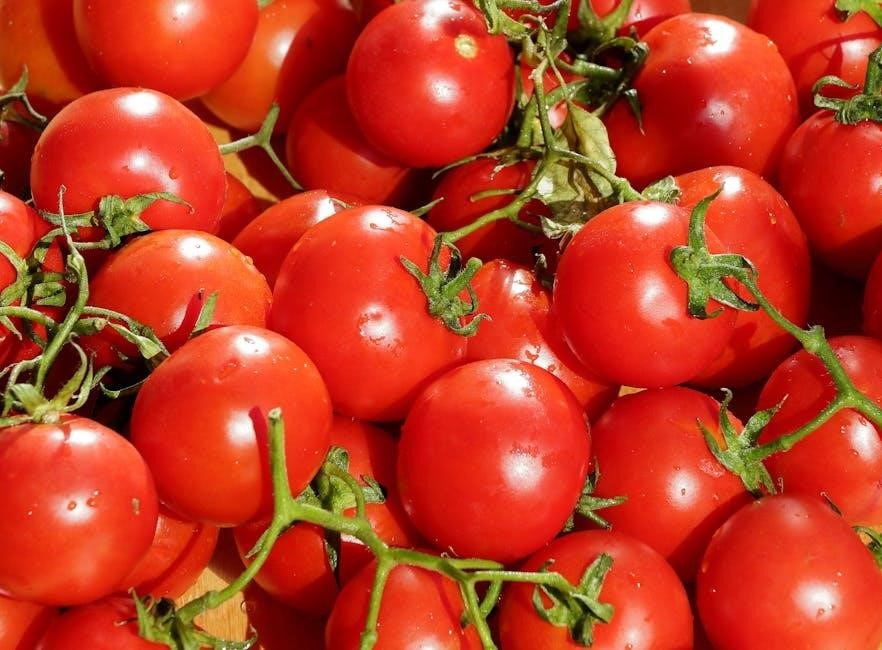The Autoimmune Paleo (AIP) Diet is a structured elimination diet designed to reduce inflammation, heal the gut, and regulate the immune system, benefiting those with autoimmune conditions.
What is the AIP Diet?
The Autoimmune Paleo (AIP) Diet is a targeted elimination diet designed to reduce inflammation, heal the gut lining, and regulate the immune system. It is an extension of the Paleo Diet but removes additional inflammatory foods like nightshades, nuts, seeds, and eggs. The AIP Diet focuses on nutrient-dense whole foods, such as grass-fed meats, leafy greens, and fermented vegetables, to promote healing and immune balance. It is particularly beneficial for individuals with autoimmune diseases like Hashimoto’s, rheumatoid arthritis, and lupus, helping to manage symptoms and improve overall well-being.
Why is the AIP Diet Important for Autoimmune Conditions?
The AIP Diet is crucial for managing autoimmune conditions by addressing the root causes of inflammation and immune dysfunction. It eliminates foods that trigger inflammation and gut damage, which are often linked to autoimmune diseases. By focusing on nutrient-dense foods, the AIP Diet helps repair the gut lining, reduce systemic inflammation, and balance the immune system. This approach can alleviate symptoms of conditions like Hashimoto’s, rheumatoid arthritis, and lupus, promoting overall healing and improving quality of life for those with autoimmune disorders.

Key Benefits of the AIP Diet
The AIP Diet reduces inflammation, heals the gut lining, regulates the immune system, and manages autoimmune diseases, promoting overall health and symptom relief effectively for many individuals.
Reducing Inflammation
The AIP Diet focuses on eliminating inflammatory foods like nightshades, nuts, and seeds, which can trigger autoimmune responses. By removing these triggers, the diet helps reduce chronic inflammation, a key driver of autoimmune diseases. This anti-inflammatory approach supports the body’s natural healing processes, leading to improved symptoms and overall well-being. The diet emphasizes nutrient-dense foods that promote gut health and immune regulation, further aiding in inflammation reduction and long-term recovery.
Healing the Gut Lining
The AIP Diet prioritizes gut healing by eliminating foods that cause gut irritation, such as nightshades and nuts, which can contribute to leaky gut syndrome. By removing these triggers, the diet promotes the repair of the gut lining, reducing permeability and inflammation. Nutrient-dense foods like bone broth, rich in collagen, and fermented foods, such as sauerkraut, support gut health by restoring the balance of gut microbiota and enhancing the body’s natural repair processes, leading to improved digestion and overall well-being.
Regulating the Immune System
The AIP Diet focuses on regulating the immune system by eliminating foods that trigger inflammation and immune overactivity. By removing allergenic and inflammatory foods, the diet helps calm the immune response, reducing autoimmune reactions. Nutrient-dense foods, such as leafy greens and organ meats, provide essential vitamins and minerals that support immune balance. This approach helps restore proper immune function, preventing it from attacking the body’s own tissues and promoting long-term health and resilience.
Managing Autoimmune Diseases
The AIP Diet is tailored to manage autoimmune diseases by addressing root causes like gut dysfunction and inflammation. By eliminating triggers such as nightshades and nuts, the diet reduces immune system overactivity. This approach supports healing and symptom relief in conditions like Hashimoto’s, rheumatoid arthritis, and lupus. The diet’s focus on nutrient-dense foods helps restore balance, enabling the body to better manage autoimmune responses and improve overall well-being.

Foods to Include and Avoid
The AIP Diet emphasizes nutrient-dense foods like grass-fed meats, fish, and vegetables, while avoiding inflammatory triggers such as grains, nightshades, nuts, seeds, and processed foods.
Foods to Eat on the AIP Diet
The AIP Diet focuses on nutrient-dense, whole foods that promote healing. Key foods include grass-fed meats, wild-caught fish, organ meats, and a variety of vegetables like leafy greens, carrots, and sweet potatoes. Healthy fats such as coconut oil, olive oil, and avocado oil are encouraged. Fermented foods like sauerkraut and kombucha support gut health. Fresh fruits, especially berries and apples, are included in moderation. Herbs like turmeric, garlic, and ginger are also allowed, provided they are not seed-based spices. These foods aim to reduce inflammation and support immune regulation.
Foods to Avoid on the AIP Diet
The AIP Diet eliminates foods known to trigger inflammation and immune responses. These include grains, legumes, nightshades like tomatoes and peppers, nuts, seeds, and eggs. Dairy products, processed foods, and added sugars are also avoided. Coffee, alcohol, and seed-based spices are excluded during the elimination phase. These foods are removed to minimize gut irritation and systemic inflammation, which are often linked to autoimmune symptoms. Avoiding them helps create a healing environment for the gut and immune system.
The Elimination Phase
The elimination phase of the AIP Diet lasts 30-90 days, removing inflammatory foods to heal the gut and reduce autoimmune symptoms effectively.
What to Expect During the Elimination Phase
During the elimination phase, you’ll remove inflammatory foods like nightshades, nuts, and seeds for 30-90 days to reduce autoimmune symptoms. Expect potential withdrawal symptoms, such as fatigue or cravings, as your body adjusts. This phase is crucial for healing the gut and calming the immune system. It’s important to stay consistent and monitor improvements in symptoms. Remember, this phase is temporary and serves as a diagnostic tool to identify food triggers. Consulting a healthcare provider or dietitian for support is recommended.
Duration of the Elimination Phase
The elimination phase typically lasts a minimum of 30 days but is often extended to 60-90 days for optimal results. This period allows the gut to heal and inflammation to subside. During this time, all potentially inflammatory foods are strictly avoided to give the immune system a chance to reset. It’s crucial to adhere to the diet without exceptions to accurately assess symptom improvement. After this phase, the reintroduction of foods can begin to identify triggers. Patience is key, as the duration ensures a thorough healing process.

Reintroduction Phase
The reintroduction phase involves gradually adding foods back to identify triggers. It requires careful monitoring of symptoms and can last several months to ensure accuracy in identifying sensitivities.
How to Reintroduce Foods
Reintroducing foods requires a systematic approach to identify triggers. Start with one food at a time, in small portions, after the elimination phase. Notice any changes in symptoms like inflammation or digestive issues. Record reactions meticulously. Gradually expand your diet while maintaining gut health. Prioritize nutrient-dense foods and avoid known irritants. Seek personalized guidance to tailor your reintroduction plan effectively, ensuring long-term health and well-being.
Identifying Food Triggers
Identifying food triggers involves monitoring your body’s response during the reintroduction phase. Keep a detailed journal to track symptoms like inflammation, digestion issues, or fatigue after consuming specific foods. Symptoms may appear immediately or days later, requiring careful observation. This process helps pinpoint which foods cause adverse reactions, enabling personalized dietary adjustments. Regular communication with healthcare providers ensures accurate assessments and supports long-term health management. By systematically identifying triggers, you can create a tailored diet that promotes healing and maintains remission from autoimmune symptoms.

Meal Planning and Recipes
Download our free AIP diet PDF for a 7-day meal plan with easy recipes, ensuring balanced and varied meals that align with the AIP protocol.
Sample 3-Day Meal Plan
A sample 3-day meal plan includes dishes like grilled salmon with roasted sweet potatoes, herb-crusted chicken with sautéed greens, and braised lamb with carrots and cauliflower. These meals focus on nutrient-dense, whole foods that support gut healing and immune regulation; The plan avoids inflammatory triggers and includes a variety of flavors to keep meals engaging. Detailed recipes and portion sizes are provided in the free AIP diet PDF, making it easy to follow and prepare delicious, compliant meals.
Easy AIP Diet Recipes
Easy AIP recipes focus on simple, nutrient-dense meals that avoid inflammatory triggers. Popular options include herb-crusted chicken with sautéed greens, braised lamb with carrots and cauliflower, and grilled salmon with roasted sweet potatoes. These recipes use AIP-friendly ingredients like fresh vegetables, lean meats, and healthy fats. They are designed to be flavorful and easy to prepare, making the AIP diet accessible for everyone. The free AIP diet PDF provides detailed instructions and additional recipe ideas to keep meals varied and delicious.
Common Concerns and FAQs
Common questions include whether the AIP diet is permanent, weight loss potential, and handling social situations. The diet is temporary, focusing on identifying food triggers and healing.
Is the AIP Diet Permanent?
The AIP diet is not intended to be a permanent lifestyle but rather a temporary protocol to identify food triggers and heal the body. Most people follow the elimination phase for 30 to 90 days before gradually reintroducing foods. Once triggers are identified, individuals transition to a personalized diet that avoids problematic foods while incorporating others. This approach allows for long-term health management without strict adherence to the initial restrictions, making it sustainable for many.
Can I Lose Weight on the AIP Diet?
Weight loss is not the primary goal of the AIP diet, but many people experience it naturally due to the elimination of processed foods and the focus on nutrient-dense meals. By removing inflammatory foods and healing the gut, the body often sheds excess weight as a secondary benefit. However, individual results vary, and the diet’s main focus remains on reducing inflammation and managing autoimmune symptoms rather than weight loss. Consult a healthcare provider for personalized guidance.
How to Handle Social Situations on the AIP Diet
Navigating social gatherings on the AIP diet requires preparation and communication. Pack AIP-friendly snacks or meals to ensure you have options. Inform your host about your dietary needs or offer to bring a dish to share. Focus on enjoying the company rather than feeling restricted. Avoiding trigger foods in social settings is crucial for maintaining progress. Plan ahead, stay confident, and embrace the opportunity to educate others about your health journey while staying committed to your goals.
The AIP diet empowers individuals to take control of their health, offering a structured approach to reduce inflammation and promote healing through nutrient-dense foods and lifestyle changes.
Final Thoughts on the AIP Diet
The AIP diet offers a transformative approach to managing autoimmune conditions by focusing on healing the gut, reducing inflammation, and regulating the immune system. By eliminating inflammatory triggers and incorporating nutrient-dense foods, individuals can reclaim their health. While the diet may seem restrictive initially, its structured phases provide clarity and empowerment. The ultimate goal is to identify personal food triggers and transition to a tailored, long-term diet. With patience and commitment, the AIP diet can be a powerful tool for achieving lasting wellness and symptom relief.
Next Steps for Starting the AIP Diet
Starting the AIP diet begins with understanding its principles and preparing for the elimination phase. Download a comprehensive AIP diet PDF guide to access detailed food lists, meal plans, and reintroduction strategies. Consult with a healthcare provider or dietitian to tailor the diet to your needs. Stock your pantry with AIP-friendly ingredients and plan your meals in advance. Begin with the elimination phase, focusing on nutrient-dense foods, and track your symptoms to monitor progress. Stay committed and patient as you embark on this journey toward healing and better health.
